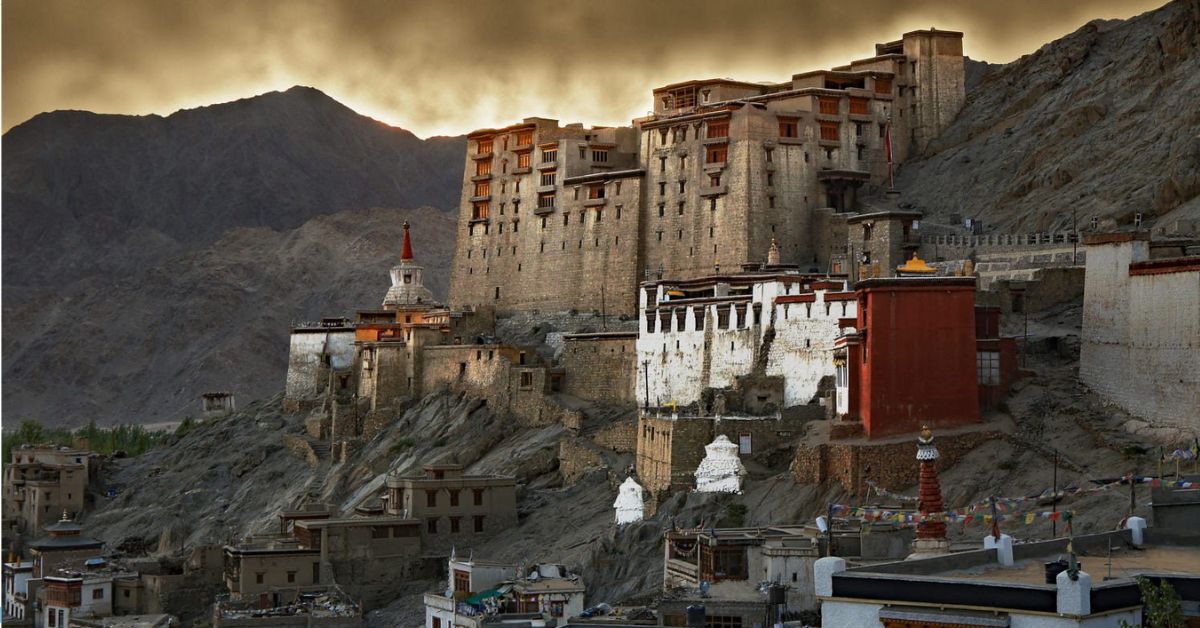Perched high above the charming town of Leh, Leh Palace stands as a majestic reminder of Ladakh’s regal past. This nine-story wonder looks like a smaller version of Tibet’s famous Potala Palace. Built by King Sengge Namgyal in the 1600s, it was once the home of Ladakh’s royal family. Today, it’s a treasure trove of history and a must-see for anyone visiting Ladakh.
Stepping inside Leh Palace feels like traveling back in time. Its thick walls and small windows were built to protect the palace from Ladakh’s harsh weather. Inside, you’ll find old paintings, fancy clothes, and ancient books that tell stories of Ladakh’s rich history.
How to reach:
By Air:
The quickest way to reach Leh is by flying into Kushok Bakula Rimpochee Airport, located about 5 kilometers from the town center. Several airlines offer flights from major cities like Delhi, Mumbai, and Srinagar. While direct flights from Delhi are convenient, connecting flights might be necessary for travelers from other places.
By Road:
For those seeking an adventurous journey, the road to Leh offers breathtaking mountain scenery. Two popular routes are:
- Manali-Leh Highway: A 473-kilometer drive with stunning landscapes, but expect a two-day journey due to high altitude.
- Srinagar-Leh Highway: Another scenic option, approximately 434 kilometers long, and also takes about two days to complete.
You can choose from state-run or private buses, or opt for a taxi for a more comfortable ride.
By Train:
Unfortunately, there’s no direct train to Leh. The closest railway stations are Jammu Tawi (about 700 kilometers away) and Pathankot (around 760 kilometers distant). From either station, you’ll need to continue your journey by bus or taxi.
Best time to visit:
Summer (May to September)
This is the peak tourist season in Leh. Expect pleasant weather with temperatures ranging from 15°C to 25°C. All roads and trekking paths are open, making it ideal for exploring Leh Palace and the surrounding area. You can also enjoy outdoor activities like trekking and biking. The famous Hemis Festival is a major highlight during this time.
Autumn (October to November)
As summer fades, autumn brings crisp, clear weather with temperatures between 5°C to 20°C. The crowds thin out, offering a more peaceful experience. The autumn foliage creates stunning scenery, making it a great time for photography.
Winter (December to February)
Leh experiences cold, snowy winters with temperatures dropping to as low as -15°C. Many roads and passes are closed due to snow. While the landscape is magical, accessibility is limited. This is the best time to visit if you enjoy winter sports or seek complete solitude.
Spring (March to April)
Spring marks the beginning of warmer weather, with temperatures gradually rising to 5°C to 15°C. The snow melts, and the region starts to bloom. Roads reopen, and trekking becomes possible. Tourist numbers are moderate, making it a good time to explore Leh Palace without large crowds.
Attractions:
The Architecture:
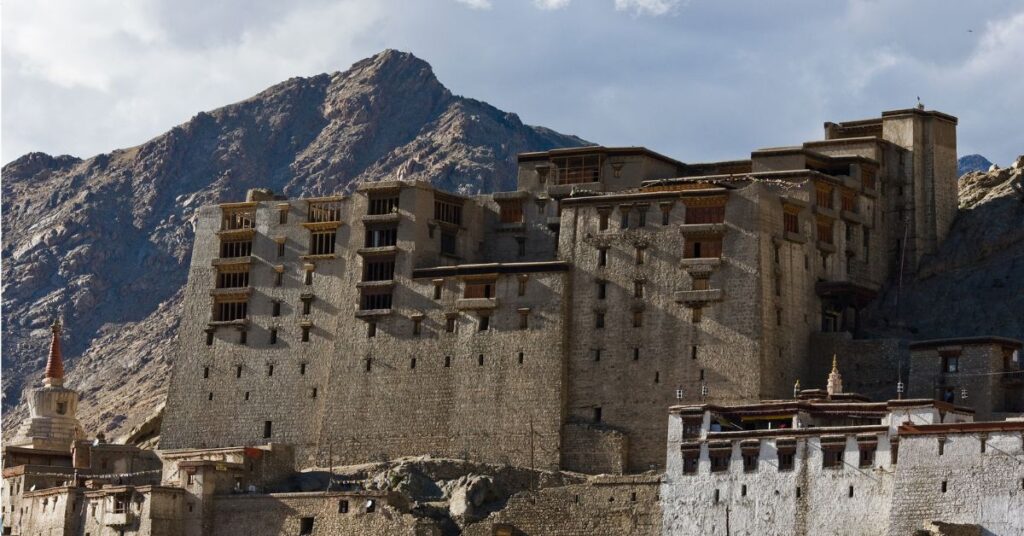
Leh Palace is a grand old building sitting high on a hill in Ladakh. Built by the Namgyal kings around 400 years ago, it’s a fantastic example of old Tibetan style. This nine-story palace looks a lot like the famous Potala Palace in Tibet. Built with stone, wood, and mud, the palace is strong and warm, perfect for Ladakh’s cold winters. The kings and their families lived on the top floors, while the lower parts were for storing things and keeping animals.
From the palace, you can see the whole town of Leh and the big mountains around it. This was important for the kings to see any danger coming. The palace is not just beautiful, but it was also very practical for life in the mountains.
Museum and Artifacts:
Leh Palace isn’t just a beautiful building. Inside, there’s a special museum filled with amazing things from Ladakh’s past. You can see old, colorful paintings called thangkas, fancy clothes the kings and queens wore, and beautiful jewelry. These things show how rich and important the people who lived in the palace once were.
The walls of the palace are covered in bright pictures of Buddha and other holy stories. These pictures are really old but still look amazing. There are also very old books that tell us about the history and beliefs of the people who lived here.
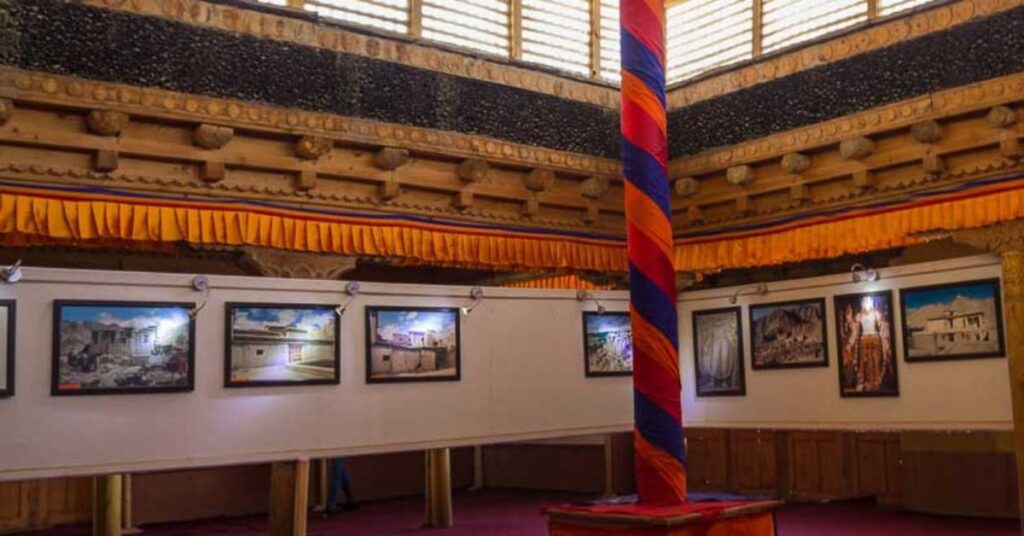
Prayer Room and Shrine:
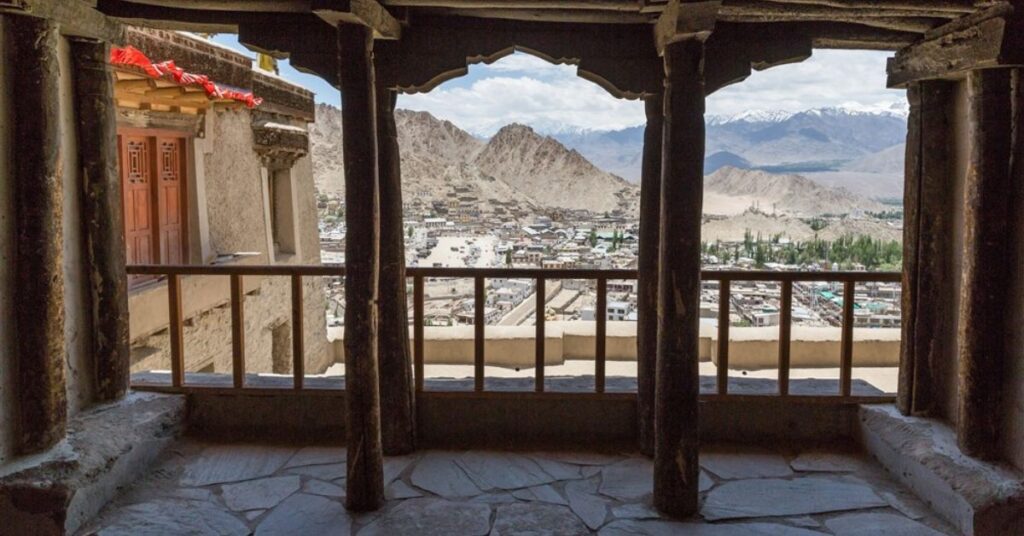
Inside the grand Leh Palace, there’s a quiet and holy space. It’s a place where people used to pray and think about spiritual things. There are pretty statues and old, wise books everywhere. You can feel calm just being there.
The kings and queens used to come here to pray and ask for good things to happen. The walls are covered in beautiful pictures and carvings that tell stories about Buddha and his teachings. In the middle of the room, there’s a special statue of Buddha with pretty lights around it.
Leh Palace Roof:
The top of Leh Palace is a magical place. From up there, you can see the whole town of Leh spread out below, and the big, beautiful mountains all around. It’s like being on top of the world! On a clear day, you can see for miles and miles. The mountains look amazing, with their brown and rocky parts and green patches by the river. It’s a picture you won’t forget.
At night, the palace roof is even more special. The sky is so clear and dark that you can see thousands of stars. It’s like a sparkling blanket spread out above you. You can even see the Milky Way!
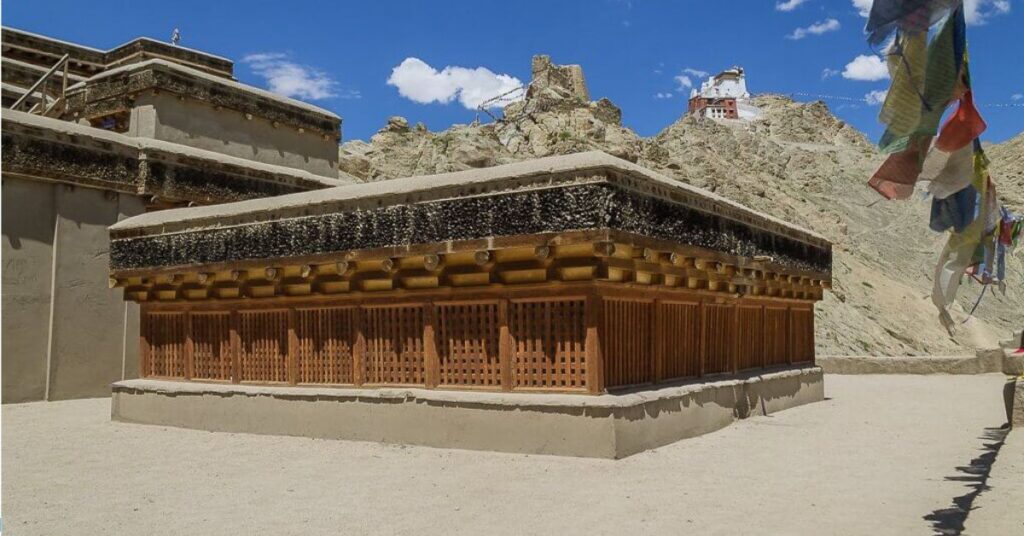
Local Exeriences:
- Immerse in History: Explore the nine-story palace, marveling at its Tibetan architecture and the royal lifestyle it once housed. Discover the palace museum’s collection of ancient artifacts, offering a glimpse into Ladakh’s rich heritage.
- Savor Stunning Views: Enjoy breathtaking panoramas of Leh town, the Indus Valley, and the majestic Himalayas from the palace’s upper floors. Capture unforgettable sunsets and sunrises with Stok Kangri as a backdrop.
- Embrace Spirituality: Find peace in the palace’s prayer room, adorned with Buddhist statues and scriptures. Experience the serene atmosphere and learn about local spiritual practices.
- Discover Local Life: Immerse yourself in Ladakhi culture by attending vibrant festivals like Hemis, exploring the nearby Leh market, or savoring delicious local cuisine.
- Outdoor Adventures: Embark on treks or bike rides starting from the palace, exploring the stunning landscapes of Ladakh.
- Explore Nearby Attractions: Visit the 15th-century Namgyal Tsemo Gompa for its impressive gold statue and panoramic views, or head to the Shanti Stupa for a peaceful retreat and stunning sunsets.
Travel tips:
- Acclimatize: Leh is at a high altitude. Spend a few days adjusting before exploring to avoid altitude sickness.
- Best Season: Visit between May and September for pleasant weather and accessible roads.
- Pack Warm: Layer your clothing as temperatures can drop, even in summer.
- Stay Hydrated: Drink plenty of water to combat altitude and dehydration.
- Necessary Permits: Obtain permits if you plan to visit restricted areas in Ladakh.
- Comfortable Footwear: Wear sturdy shoes for exploring the palace’s uneven terrain.
- Capture the Moment: Bring a camera to capture the stunning views and architectural details.
- Respectful Attire: Dress modestly and respect local customs, especially in religious sites.
- Cash is King: Carry sufficient cash as card payments might be limited.
- Guided Tour: Consider a local guide to enrich your understanding of the palace’s history.
- Altitude Sickness Prevention: Consult your doctor and carry necessary medication if needed.
- Sun Protection: Shield yourself from the strong mountain sun with sunscreen, sunglasses, and a hat.
- Eco-Friendly Travel: Minimize your environmental impact by using reusable items and respecting the local environment.
- Local Transport: Opt for local taxis or bike rentals for convenient transportation.
- Food Safety: Eat at reputable places and drink bottled water to avoid stomach upset.
- Emergency Preparedness: Keep emergency contact information handy.
- Cultural Sensitivity: Respect local customs and ask permission before photographing people.
Conclusion
Leh Palace is a majestic testament to Ladakh’s rich history, showcasing architectural brilliance and cultural depth. This nine-story marvel, perched strategically for panoramic views, offers a captivating journey into the life of the Namgyal dynasty. From its Tibetan-inspired design to the museum’s intriguing artifacts and the serene prayer rooms, Leh Palace leaves an enduring impression. Beyond its historical significance, the palace is a gateway to Ladakh’s natural wonders, from the towering Stok Kangri to the tranquil Shanti Stupa. Immerse yourself in local festivals and traditions for a truly enriching experience. To make the most of your visit, plan ahead, respect local customs, and embrace sustainable practices. Xplro.com offers valuable insights to ensure an unforgettable Leh Palace adventure.
FAQs
- What is the ideal time to visit Leh Palace?
- The optimal time to visit Leh Palace is between May and September when the weather is favorable, and all travel routes are open.
- How do I get to Leh Palace?
- Leh Palace is situated in Leh town, Ladakh. You can fly directly to Leh from major Indian cities like Delhi, Mumbai, and Srinagar. Once in Leh, the palace is easily accessible by foot from the town center or by local taxi.
- What are the visiting hours of Leh Palace?
- Leh Palace is open to visitors from 7:00 AM to 4:00 PM daily.
- Is there an entry fee for Leh Palace?
- Yes, there is a small entry fee. For Indian citizens, it is typically around INR 15-20, and for foreign tourists, it is about INR 100.
- How much time should I allocate to visit Leh Palace?
- Plan to spend 1-2 hours at Leh Palace to thoroughly explore its architecture, museum exhibits, and the panoramic views.
- Is there a guide available at Leh Palace?
- Yes, local guides are available and can provide in-depth historical and cultural insights. Hiring a guide is recommended for a more enriching experience.
- What should I wear when visiting Leh Palace?
- Wear comfortable, layered clothing as temperatures can vary. Also, wear sturdy walking shoes and bring a hat, sunglasses, and sunscreen for sun protection.
- Are there any restrictions on photography at Leh Palace?
- Photography is generally allowed, but it is always best to check with palace staff for any specific restrictions, especially inside the museum and prayer rooms.
- Can I visit Leh Palace with children?
- Yes, Leh Palace is suitable for children, but be mindful of the many stairs and uneven surfaces, requiring close supervision.
- Is Leh Palace accessible for people with disabilities?
- Due to its historic design and hillside location, Leh Palace may not be easily accessible for people with mobility issues, as it involves climbing stairs and navigating uneven paths.
- Are there restroom facilities at Leh Palace?
- Basic restroom facilities are available at Leh Palace. However, they might not be as modern as those in urban areas, so plan accordingly.
- What other attractions can I visit near Leh Palace?
- Nearby attractions include Namgyal Tsemo Gompa, Shanti Stupa, Leh Market, and various trekking routes. These sites offer additional cultural and scenic experiences to enhance your visit to Leh Palace.


